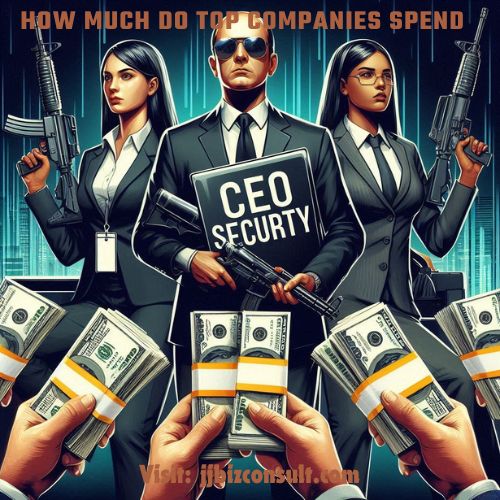CEO Security: How Much Do Top Companies Spend to Protect Their Leaders?

In today’s ever-evolving world, CEOs face a unique set of security threats. From disgruntled employees and activist protestors to cyberattacks and kidnapping attempts, the need for robust CEO security has never been greater. But how much do top companies spend to safeguard their leaders, and what are the factors that influence this cost?
The High Price of Protection
While specific figures can be difficult to pinpoint due to security concerns and competitive advantage strategies, estimates suggest that top companies can spend anywhere from hundreds of thousands to millions of dollars annually on CEO security. This cost can encompass a wide range of services, including:
- Executive protection specialists: These highly trained individuals act as bodyguards, accompanying the CEO during travel, public appearances, and other potentially risky situations.
- Security technology: This can include bulletproof vehicles, advanced surveillance systems, and secure communication channels.
- Threat assessments and intelligence gathering: Security teams constantly monitor potential threats and develop strategies to mitigate risks.
- Home security upgrades: The CEO’s residence may require extensive security measures, including alarm systems, perimeter security, and access control systems.
Factors Affecting CEO Security Costs

Several factors influence the cost of CEO security, including:
- Industry: CEOs in certain industries, such as technology, finance, and pharmaceuticals, may be more susceptible to targeted attacks. This can lead to a higher security budget.
- Company size and profile: Larger companies with a higher public profile will typically invest more in CEO security compared to smaller, lesser-known firms.
- Location: CEOs operating in regions with a higher threat level will require more security measures than those in safer areas.
- Travel frequency: CEOs who travel frequently require additional security considerations, such as advanced planning for travel routes and accommodation security.
- Specific threats: If a CEO has received credible threats, the security response will be more extensive and expensive.
Beyond the Bodyguards: A Holistic Approach to CEO Security
While physical security is crucial, a comprehensive approach to CEO security goes beyond bodyguards. It’s essential to consider:
- Cybersecurity: CEOs are prime targets for cyberattacks. Strong cybersecurity measures are necessary to protect personal and company data.
- Crisis management planning: Having a well-defined plan in place to deal with security breaches, kidnappings, or other emergencies can minimize damage and ensure a swift response.
- Employee background checks: Thorough background checks on all employees, particularly those with close access to the CEO, can be a vital preventative measure.
The ROI of CEO Security

The cost of CEO security may seem high, but it pales in comparison to the potential consequences of a successful attack. Reputational damage, financial losses, and even the safety of the CEO themselves are all at stake. Investing in robust security measures not only protects the CEO but also gives the company peace of mind and allows the leader to focus on strategic business objectives.
1. The Rising Trend in CEO Security Spending
Despite economic challenges and budget constraints, cybersecurity budgets continue to rise. Based on a survey of over 600 security executives, we find that security accounts for approximately 10% of IT spending on average across industries. However, some sectors invest even more:
- Tech Companies: Technology firms allocate an average of 13% of their IT budget to security.
- Healthcare and Business Services: These sectors also spend slightly above the industry average.
2. Company Size Matters
The size of a company significantly impacts its security spending. Here’s how different market capitalization tiers allocate their IT budgets to cybersecurity:
- Smallest Companies (Market Cap ≤ $300M): These companies invest the highest proportion (22.7%) of their IT budget in cybersecurity.
- Largest Companies (Market Cap ≥ $100B): The largest corporations allocate the lowest share (6.8%) of their IT budgets to cybersecurity.
3. Factors Driving Increased Security Budgets
Several factors contribute to the upward trend in security spending:
- Company Growth: As businesses expand, so do security needs.
- Business Security: Executives recognize the importance of safeguarding critical assets.
- Cyberattack Risks: Heightened awareness of cyber threats drives budget increases.
- High-Profile Breaches: Notable security incidents prompt companies to allocate more resources.
4. Allocation of Cybersecurity Budget
Where do companies allocate their cybersecurity budget? Here’s the breakdown:
- Staff and Compensation: The largest share (39%) goes toward hiring and retaining security professionals.
- Software: Companies allocate 28% of their budget to security software.
- Outsourcing: Approximately 10% of the budget is spent on outsourcing security services.
5. Notable Examples of CEO Security Spending

Let’s take a closer look at specific companies and their investments in CEO security:
- Amazon: Since 2010, Amazon has consistently spent $1.6 million annually on business and travel security for CEO Jeff Bezos.
- Oracle: Oracle allocates around $1.5 million per year for security at Chairman Larry Ellison’s residence.
- Facebook: In 2020, Facebook spent a staggering $23.4 million to protect CEO Mark Zuckerberg.
Mark Zuckerberg’s Personal Security Spending
Mark Zuckerberg, the co-founder and CEO of Meta (formerly known as Facebook), has a robust security program in place to ensure his safety. Let’s delve into the details:
- Total Spending in 2021:
- Meta earmarked nearly $27 million for what it described as an “overall security program” for Zuckerberg. This total includes:
- Personal Security at Residences: Approximately $15.2 million was spent on personal security for Mr. Zuckerberg at his residences.
- Security During Personal Travel: Costs related to security personnel during his personal travel were also covered.
- Additional Security Measures: This includes the procurement, installation, and maintenance of certain security measures for his residences.
- Notably, Meta spends far more on Zuckerberg’s security than other companies spend on their own executives. For instance:
- Google spent $4.3 million on security for its chief executive, Sundar Pichai.
- Berkshire Hathaway allocated a mere $273,000 for Warren Buffett’s security last year.
- Meta earmarked nearly $27 million for what it described as an “overall security program” for Zuckerberg. This total includes:
- Reasons for High Security Costs:
- Mr. Zuckerberg’s unique position as the face of Meta contributes to the substantial investment in his security. He is synonymous with the company, and negative sentiment regarding Meta is often associated with him.
- His global media exposure, legislative attention, and regulatory scrutiny further justify the significant spending on his safety.
- The costs associated with his security increased by 6% between 2020 and 2021, primarily due to regular personal travel, security protocols during the COVID-19 pandemic, and market increases in security personnel costs.
- Salary and Compensation:
- Interestingly, Zuckerberg takes a symbolic $1 salary and does not receive bonuses or equity awards like many other tech executives do.
- Despite this, Meta invests heavily in his security, recognizing the critical role he plays in the company’s success.
In summary, Mark Zuckerberg’s security is a top priority for Meta, and the company allocates substantial resources to ensure his safety and protect its reputation. As one of the most recognized executives globally, his security program reflects the unique challenges he faces as a high-profile leader. 🛡️👨💼🔒
The Future of CEO Security
As technology evolves and threats become more sophisticated, the landscape of CEO security will continue to change. Emerging technologies, such as artificial intelligence and advanced surveillance systems, are likely to play a larger role in protecting CEOs in the future. However, the importance of a well-trained and experienced security team, combined with a holistic approach that addresses all potential vulnerabilities, will remain paramount.
In Conclusion
CEO security is a complex and ever-evolving field. By understanding the factors that influence the cost and the different aspects of a comprehensive security strategy, companies can make informed decisions about how to best protect their leaders. After all, a safe CEO is a CEO who can effectively lead the company towards success.
For more insights, check out the Security Budget Benchmark Summary Report 2022 by ISTARI.
The Most Valuable Companies in the World & their CEO’s
Tech CEO: Navigating the Billion-Dollar Landscape





